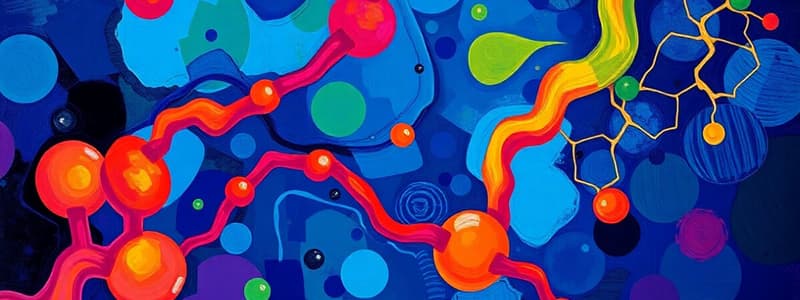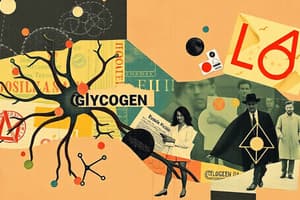Podcast
Questions and Answers
What is the primary role of insulin in regulating glycogen metabolism?
What is the primary role of insulin in regulating glycogen metabolism?
- Promoting glycogen synthesis by activating phosphoprotein phosphatase. (correct)
- Stimulating the release of glucagon to inhibit glycogen synthesis.
- Activating glycogen phosphorylase to increase glycogen breakdown.
- Inhibiting protein phosphatase to prevent dephosphorylation of glycogen synthase.
How does glucagon influence glycogen metabolism in the liver?
How does glucagon influence glycogen metabolism in the liver?
- It inhibits glycogen phosphorylase.
- It promotes glycogenolysis and inhibits glycogen synthesis. (correct)
- It activates glycogen synthase.
- It stimulates glucose uptake from the blood.
Which of the following represents the correct relationship between glycogen synthase activity and its phosphorylation state?
Which of the following represents the correct relationship between glycogen synthase activity and its phosphorylation state?
- Phosphorylation has no effect on glycogen synthase activity.
- Glycogen synthase is active when it is dephosphorylated. (correct)
- Glycogen synthase is active when it is phosphorylated.
- Glycogen synthase activity is only affected by allosteric regulators.
What is the role of cAMP in the hormonal regulation of glycogen metabolism?
What is the role of cAMP in the hormonal regulation of glycogen metabolism?
How does epinephrine regulate glycogen metabolism in muscle cells?
How does epinephrine regulate glycogen metabolism in muscle cells?
What is the effect of elevated levels of ATP and glucose-6-phosphate on glycogen phosphorylase?
What is the effect of elevated levels of ATP and glucose-6-phosphate on glycogen phosphorylase?
Under conditions of low blood sugar, what hormonal change would you expect to observe?
Under conditions of low blood sugar, what hormonal change would you expect to observe?
How does the presence of AMP affect glycogen phosphorylase activity in muscle?
How does the presence of AMP affect glycogen phosphorylase activity in muscle?
Which of the following is true regarding the effect of insulin on glycogen phosphorylase?
Which of the following is true regarding the effect of insulin on glycogen phosphorylase?
What is the role of Calcium (Ca2+) in the activation of glycogen breakdown in muscles?
What is the role of Calcium (Ca2+) in the activation of glycogen breakdown in muscles?
How do epinephrine and glucagon influence glycogen metabolism?
How do epinephrine and glucagon influence glycogen metabolism?
What triggers the activation of phosphoprotein phosphatase?
What triggers the activation of phosphoprotein phosphatase?
During extended exercise, what metabolic fuel source becomes more important for muscle cells as glycogen stores are depleted?
During extended exercise, what metabolic fuel source becomes more important for muscle cells as glycogen stores are depleted?
In liver cells, what is the consequence of Protein Kinase A (PKA) activation on glycolysis and gluconeogenesis?
In liver cells, what is the consequence of Protein Kinase A (PKA) activation on glycolysis and gluconeogenesis?
Which statement accurately describes the allosteric regulation of glycogen synthase?
Which statement accurately describes the allosteric regulation of glycogen synthase?
How does the liver respond to the cAMP cascade triggered by glucagon?
How does the liver respond to the cAMP cascade triggered by glucagon?
In muscle cells, what is the direct effect of Ca2+ binding to phosphorylase kinase?
In muscle cells, what is the direct effect of Ca2+ binding to phosphorylase kinase?
What is the functional consequence of phosphorylating a serine hydroxyl group on glycogen phosphorylase?
What is the functional consequence of phosphorylating a serine hydroxyl group on glycogen phosphorylase?
Which of the following best describes the mechanism by which insulin antagonizes the effects of glucagon and epinephrine?
Which of the following best describes the mechanism by which insulin antagonizes the effects of glucagon and epinephrine?
What metabolic adaptation occurs in muscle cells under conditions of extreme anoxia and ATP depletion?
What metabolic adaptation occurs in muscle cells under conditions of extreme anoxia and ATP depletion?
A researcher is studying liver cells and observes increased glycogen synthesis. Which of the following conditions would most likely explain this observation?
A researcher is studying liver cells and observes increased glycogen synthesis. Which of the following conditions would most likely explain this observation?
Which of the following responses would be expected following a carbohydrate-rich meal?
Which of the following responses would be expected following a carbohydrate-rich meal?
Which of the following is a characteristic of glycogen phosphorylase?
Which of the following is a characteristic of glycogen phosphorylase?
Which hormone promotes glycogen breakdown in both liver and muscle tissue?
Which hormone promotes glycogen breakdown in both liver and muscle tissue?
Which of the following is a substrate for adenylyl cyclase?
Which of the following is a substrate for adenylyl cyclase?
Flashcards
Glycogen Synthesis
Glycogen Synthesis
The production of glycogen from glucose, stimulated by high energy levels.
Glycogen Degradation
Glycogen Degradation
The breakdown of glycogen into glucose, increased when energy levels are low.
Dephosphorylated Form
Dephosphorylated Form
Glycogen synthase is active in this form.
Glucagon's Effect
Glucagon's Effect
Signup and view all the flashcards
Insulin's Role
Insulin's Role
Signup and view all the flashcards
Adenylyl Cyclase
Adenylyl Cyclase
Signup and view all the flashcards
Cyclic AMP (cAMP)
Cyclic AMP (cAMP)
Signup and view all the flashcards
Phosphodiesterase
Phosphodiesterase
Signup and view all the flashcards
Covalent Modification
Covalent Modification
Signup and view all the flashcards
Glucagon & Epinephrine
Glucagon & Epinephrine
Signup and view all the flashcards
Phosphorylation (cAMP Cascade)
Phosphorylation (cAMP Cascade)
Signup and view all the flashcards
Allosteric Inhibitors
Allosteric Inhibitors
Signup and view all the flashcards
Free Glucose
Free Glucose
Signup and view all the flashcards
Phosphoprotein Phosphatase
Phosphoprotein Phosphatase
Signup and view all the flashcards
Glycogen Phosphorylase
Glycogen Phosphorylase
Signup and view all the flashcards
Homodimeric Enzyme
Homodimeric Enzyme
Signup and view all the flashcards
Glycogen Phosphorylase Conformations
Glycogen Phosphorylase Conformations
Signup and view all the flashcards
AMP (Muscle Tissue)
AMP (Muscle Tissue)
Signup and view all the flashcards
ATP & Glucose-6-phosphate
ATP & Glucose-6-phosphate
Signup and view all the flashcards
Glycogen Synthase Activation
Glycogen Synthase Activation
Signup and view all the flashcards
Calcium Ions
Calcium Ions
Signup and view all the flashcards
Phosphorylation (Enzyme)
Phosphorylation (Enzyme)
Signup and view all the flashcards
Reciprocal Effects
Reciprocal Effects
Signup and view all the flashcards
Gluconeogenesis
Gluconeogenesis
Signup and view all the flashcards
Glycolysis
Glycolysis
Signup and view all the flashcards
Study Notes
Regulation of Glycogen Metabolism
- Glycogen synthase has active and inactive forms in synthesis.
- Glycogen phosphorylase has active and inactive forms in degradation.
- Regulation occurs allosterically and hormonally.
- Glycogen synthesis is stimulated when energy levels and substrate availability are high.
- Glycogen degradation increases when energy levels are low.
- ATP blocks the allosteric site to which AMP binds and inactivates glycogen synthase when energy levels are adequate and glucose supplies are available.
Hormonal Regulation of Glycogen Synthesis
- High glucose concentrations stimulate the pancreas.
- Insulin is released into the bloodstream as a result of the stimulation.
- Glucagon release is simultaneously stopped.
- Glycogen synthase activation is tightly linked to glycogen phosphorylase inhibition.
- Glycogen synthase is active in its dephosphorylated form.
- It responds to hormonal action in the presence of insulin.
- Dephosphorylation occurs via protein phosphatase.
- Glycogen phosphorylase is inactive in its dephosphorylated form, leading to no glycogen breakdown.
- Glycogen phosphorylase is active, and glycogen synthase is inactive in the presence of glucagon.
Hormonal Regulation and cAMP
- Cyclic AMP (cAMP) forms from ATP via adenyl cyclase on the inner surface of cell membranes.
- Cyclic AMP acts as an intracellular second messenger
- It responds to hormones like epinephrine, norepinephrine, and glucagon.
- cAMP is hydrolyzed by phosphodiesterase, which terminates hormone action.
- In the liver, insulin increases the activity of phosphodiesterase.
- Glucagon and epinephrine activate G-protein coupled receptors to trigger cAMP cascades.
- Both hormones are produced in response to low blood sugar.
- Glucagon, from α-cells of the pancreas, activates cAMP formation in the liver.
- Epinephrine activates cAMP formation in muscle.
cAMP Cascade Effects
- The cAMP cascade phosphorylates a serine hydroxyl of Glycogen Phosphorylase.
- This phosphorylation promotes transition to the active (relaxed) state.
- The phosphorylated enzyme becomes less sensitive to allosteric inhibitors.
- Phosphorylase will be active even if cellular ATP & glucose-6-phosphate are high.
- Glucose-1-phosphate produced from glycogen in the liver can be converted to free glucose for release into the blood.
- Organism needs take precedence over cell needs with hormone-activated regulation.
- The cAMP cascade has the opposite effect on glycogen synthesis as induced by glucagon or epinephrine in the liver.
- Glycogen Synthase is phosphorylated by Protein Kinase A and Phosphorylase Kinase.
- Phosphorylation of Glycogen Synthase promotes the "b" (less active) conformation.
- The cAMP cascade inhibits glycogen synthesis.
- Glucose-1-P in the liver can be converted to glucose-6-P and dephosphorylated for release to the blood instead of being converted to glycogen.
Insulin and Phosphoprotein Phosphatase
- Insulin is produced in response to high blood glucose.
- Insulin triggers a separate signal cascade which activates Phosphoprotein Phosphatase.
- This phosphatase removes regulatory phosphate residues from Phosphorylase, Phosphorylase Kinase, and Glycogen Synthase enzymes.
- Insulin antagonizes the effects of the cAMP cascade induced by glucagon and epinephrine.
Glycogen Degradation
- Blood glucose drops, or energy demand increases in response to glucagon or epinephrine.
- Glycogen phosphorylase activity increases to provide glucose.
- Glycogen Phosphorylase is a homodimeric enzyme subject to allosteric control.
- It transitions between “relaxed” (active) & “tense” (inhibited) conformations.
- Inhibitors bind at the dimer interface, stabilizing the inactive (tense) conformation.
- Glycogen Phosphorylase in muscle is subject to allosteric regulation by AMP, ATP, and glucose-6-phosphate.
- A separate isozyme of Phosphorylase expressed in the liver is less sensitive to allosteric controls.
- AMP (present significantly when ATP is depleted) activates Phosphorylase
- This promotes the relaxed conformation.
- ATP & glucose-6-phosphate have binding sites that overlap that of AMP
- ATP & glucose-6-phosphate inhibit Phosphorylase, promoting the tense conformation.
- When ATP and glucose-6-phosphate are plentiful, glycogen breakdown is inhibited.
Glycogen Synthase and Glucose-6-P
- Glycogen Synthase is allosterically activated by glucose-6-P (opposite of effect on Phosphorylase).
- Glycogen Synthase is active when high blood glucose leads to elevated intracellular glucose-6-P.
- It is useful to store glucose as glycogen when the input to Glycolysis (glucose-6-P) and the main product of Glycolysis (ATP) are adequate.
- High cytosolic glucose-6-phosphate, resulting from high blood glucose, turns off the signal for glycogen synthesis.
- The conformation of Glycogen Synthase induced by the allosteric activator glucose-6-phosphate becomes susceptible to dephosphorylation by Protein Phosphatase.
Role of Ca2+
- There is a rapid and urgent need for ATP during muscle contraction.
- This energy is supplied by muscle glycogen stores.
- Nerve impulses cause membrane depolarization
- Ca2+ is released from the sarcoplasmic reticulum into the sarcoplasm of myocytes as a result.
- Ca2+ activates muscle phosphorylase kinase b by binding to the calmodulin component (CaM subunit) of phosphorylase kinase.
- Ca++ regulates glycogen breakdown in muscle.
- Phosphorylase Kinase is partly activated by binding of Ca++ to its subunit.
- During extended exercise, as glycogen stores deplete, muscle cells rely more on glucose uptake from the blood
- They also rely fatty acid catabolism as a source of ATP.
- Phosphorylation of the enzyme, via a cAMP cascade induced by epinephrine, further activates it.
- These regulatory processes ensure the release of phosphorylated glucose from glycogen for entry into Glycolysis for ATP production in muscle contraction.
Control in Liver Cells
- Control in liver cells includes reciprocal effects (on glycolysis and gluconeogenesis) of a cyclic AMP cascade, triggered by glucagon when blood glucose is low.
- Phosphorylation of enzymes & regulatory proteins in the liver by Protein Kinase A result in: inhibition of glycolysis and stimulation of gluconeogenesis.
- Liver creates glucose to the available to the blood.
Effects of glucagon-cAMP cascade in the Liver
- Gluconeogenesis, glycogen breakdown stimulated.
- Glycolysis and glycogen synthesis is inhibited.
- Free glucose is formed for release into the blood.
Studying That Suits You
Use AI to generate personalized quizzes and flashcards to suit your learning preferences.




